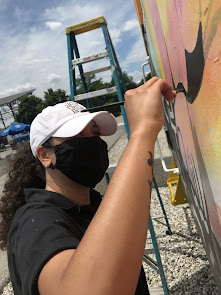Artist Spotlight: Jennifer Weightman
It's no surprise that artist Jennifer Weightman self-identifies as a writer. After all, the words "Connecting Us" are the focal point of the mural she designed for the B&O Street Art Project. It feels as though this statement finds its power in its brevity; a charmingly undistilled and intuitive statement on trains, art, and community.
Jennifer is originally from southern Maryland, and has been living in Baltimore for about four years. An early initiate into the world of street art, Jennifer showed an initial interest in sewing, doodling, and photography, but first began doing graffiti at age 15, when a friend asked her to tag along on a date she was going on—no pun intended. She's been a writer ever since.
For Jennifer, the significance of displaying graffiti at the B&O Railroad Museum is the opportunity to remind viewers that graffiti and street art are "just as much a part of the story" of railroading history as anything else, citing, for example, the fact that even model railroaders collect model train cars covered in graffiti decals, a testament to the undeniable interconnectedness of the artform and the railroad.
When asked what sets street art apart from other mediums, Jennifer explains that she "did not come from a well-off family," speaking to the accessibility of the artform. It seems that this accessibility also gives rise to a certain intimacy shared between both the community of artists themselves and the viewer, as Jennifer compares tagged train cars to "diary entries." For street artists, the whole of the external world is a prospective canvas, and Jennifer is frank about the fact that while certainly art, graffiti remains by definition a form of vandalism, unabashedly stating that "It is what it is." According to Jennifer, street art is an extension of the human instinct to say "Hey, I'm here," and if corporations can visually represent themselves in the world around us, then artists can too.
In determining how to approach the Street Art Project's theme of connectedness, Jennifer speaks to the sense of community and connection she often feels when seeing the tags of fellow artists on train cars, a sentiment clearly reflected in the circular railroad tracks beneath the words in her mural. In response to the prompt (Jennifer specifically recalls the mention of "Baltimore and the nation"), her piece pays tribute to the role that Baltimore and its railroads played historically as a conduit for the spread of graffiti down the eastern seaboard. Jennifer's piece represents the connections between the city, the railroad, the artform and the nation—a multi-layered symbol of and statement on community. It was also important to Jennifer that her piece did not just represent Baltimore, but that it do so authentically, evoking the city's "working-class atmosphere."
Jennifer works full time as an ultrasound researcher, and admits that she's had "an interesting journey" in finding the balance between her career and her work as an artist. She is grateful for being able to work from home, feeling that it helps to preserve her energy for her own artistic pursuits. She admits that she sometimes wonders "where would I be if I committed [to art] full-time," but likes the idea of doing art not as a career, but as a "human activity that can...make you feel good."
In discussing what she wants the takeaway to be for visitors who see her piece, Jennifer reprises the theme of connection that is interpreted so stunningly in her mural, pointing out that train enthusiasts and graffiti artists "share a lot of the same feelings about trains, you're coming to look at trains, you know, so do writers. We love these, like, big pieces of moving metal, too."
Jennifer's mural is indeed imbued with her love for these "big pieces of moving metal" as it is with the sense of community she feels as a graffiti writer, and the historically working-class roots of the city of Baltimore. At the intersection of all these elements of Jennifer's mural, the theme of connectedness is masterfully represented, perpetually active in the infinite loop of railroad track and the pervasive, perpetual phrase "Connecting Us."
Follow Jennifer on Instagram: @w8jenn









